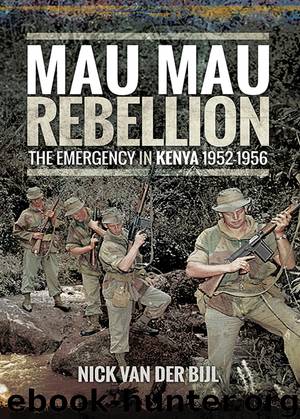Mau Mau Rebellion by Nicholas van der Bijl

Author:Nicholas van der Bijl
Language: eng
Format: epub
Publisher: Pen and Sword
Published: 2017-07-30T16:00:00+00:00
Chapter 8
Consolidation 1953
In July, General Erskine prepared for his third phase by handing over internal security in Fort Hall District to the civil authorities, in order to release the Army to dominate the two Prohibited Areas. But he was hindered by the ramifications of the killings in Meru District. In mid-August, Major Griffiths was transferred to the East Africa Depot and Training Centre and General Erskine relieved Brigadier Cornah and Lieutenant Colonel Evans of their commands. Brigadier J.R.H. Orr took command of 70 (East African) Brigade. Commissioned into the Indian Army, he had seen service in North Africa with the 11th Prince Albert Victor’s Own Cavalry (Frontier Force) and then transferred to the Mahrattas. After Partition, he was accepted by the Royal Welch Fusiliers and seconded to the KAR. When General Erskine sought assurances from the two brigade commanders that abuses were not occurring, Orr reminded 70th (East African) Brigade on 8 September that prisoners were to be treated within the law and that killing competitions were to cease. A fortnight later, he issued orders that prisoners were not to be mistreated in the pursuit of intelligence.
So far, operations had largely been unproductive and the intelligence produced had been inaccurate. There were thought to be about 5,000 Mau Mau in the Mt Kenya Prohibited Area and 6,000 in the Aberdares, and while insufficient weapons and the difficulty of procuring food supplies were hindering recruitment, the Passive Wing was passing intelligence of military operations from the assembly of troops. The Militant Wing responded by melting deeper into the forest, knowing that the troops opposing them were not as skilled in forest warfare, were confined to the paths, were noisy when patrolling and then returned to their camps once the patrols had left. Erskine realized that the Mau Mau could not be defeated by military operations alone and wrote to Marshal Harding on 15 August: ‘Unless we deal with the fundamental causes which allowed the Mau Mau to grow and prosper, we shall get further trouble in a different form.’ Erskine still had too few troops, and when he asked for another brigade, in September, 49 Independent Infantry Brigade began arriving from England with 1 Royal Northumberland Fusiliers and 1 Royal Inniskilling Fusiliers, the first of two Irish battalions to serve in the Emergency. The Brigade had been on the Western Front during the First World War and during the Second had fought in the 1940 Norwegian Campaign, defended Iceland and then landed in Normandy. Its insignia was a polar bear. In 39 Brigade, 1st Black Watch replaced the Lancashire Fusiliers, and 70 Brigade was joined by 3 (Kenya) KAR returning from Malaya. With the equivalent of a division, Erskine could now apply further pressure on the Mau Mau as follows:
• 39 Brigade: East Aberdares, Fort Hall, South Nyeri and Thika
• 49 Brigade: West Aberdares and the Rift Valley
• 70 Brigade: Mount Kenya, Embu, Meru and Nanyuki
When the Devons returned to their hunting ground between the Gura and Mathioya rivers in mid-August,
Download
This site does not store any files on its server. We only index and link to content provided by other sites. Please contact the content providers to delete copyright contents if any and email us, we'll remove relevant links or contents immediately.
| Africa | Americas |
| Arctic & Antarctica | Asia |
| Australia & Oceania | Europe |
| Middle East | Russia |
| United States | World |
| Ancient Civilizations | Military |
| Historical Study & Educational Resources |
Pirates of Somalia by Jay Bahadur(1351)
Out of Africa by Isak Dinesen(790)
I Am Evelyn Amony by Evelyn Amony(508)
A History of the East African Coast by Charles Cornelius(502)
Dreams in a Time of War: A Childhood Memoir by Ngugi Wa Thiong'o(494)
Where Soldiers Fear to Tread by John Burnett(463)
Swahili Port Cities by prita meier(457)
Aagaard's African Adventures by Finn Aagaard(440)
Mugabe: Power, Plunder, and the Struggle for Zimbabwe's Future by Martin Meredith(392)
Inside the Hotel Rwanda by Edouard Kayihura(383)
The Addis Ababa Massacre by Campbell Ian;(367)
Mau Mau Rebellion by Nicholas van der Bijl(365)
Terrorism, Betrayal, and Resilience by Prudence Bushnell(354)
Terrorism, Betrayal, and Resilience: My Story of the 1998 U.S. Embassy Bombings by Prudence Bushnell(315)
The First Victory by Andrew Stewart(313)
Common People's Uganda by Yash Tandon(295)
Air War East Africa 1940-41: The RAF Versus the Italian Air Force by Jon Sutherland & Diane Canwell(266)
UNDERSTANDING CONTEMPORARY ETHIOPIA by GÉRARD PRUNIER; ÉLOI FICQUET(257)
